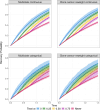Causal Multistate Models to Evaluate Treatment Delay
- PMID: 40200098
- PMCID: PMC11978571
- DOI: 10.1002/sim.70061
Causal Multistate Models to Evaluate Treatment Delay
Abstract
Multistate models allow for the study of scenarios where individuals experience different events over time. While effective for descriptive and predictive purposes, multistate models are not typically used for causal inference. We propose an estimator that combines a multistate model with g-computation to estimate the causal effect of treatment delay strategies. In particular, we estimate the impact of strategies such as awaiting natural recovery for 3 months, on the marginal probability of recovery. We use an illness-death model, where illness and death represent, respectively, treatment and recovery. We formulate the causal assumptions needed for identification and the modeling assumptions needed to estimate the quantities of interest. In a simulation study, we present scenarios where the proposed method can make more efficient use of data compared to an alternative approach using cloning-censoring-reweighting. We then showcase the proposed methodology on real data by estimating the effect of treatment delay on a cohort of 1896 couples with unexplained subfertility who seek intrauterine insemination.
Keywords: causal inference; g‐computation; multistate model; observational data; survival analysis.
© 2025 The Author(s). Statistics in Medicine published by John Wiley & Sons Ltd.
Conflict of interest statement
The authors declare no conflicts of interest.
Figures



Similar articles
-
A connection between survival multistate models and causal inference for external treatment interruptions.Stat Methods Med Res. 2023 Feb;32(2):267-286. doi: 10.1177/09622802221133551. Epub 2022 Dec 4. Stat Methods Med Res. 2023. PMID: 36464917 Free PMC article.
-
Targeted maximum likelihood based causal inference: Part I.Int J Biostat. 2010;6(2):Article 2. doi: 10.2202/1557-4679.1211. Int J Biostat. 2010. PMID: 21969992 Free PMC article.
-
Blood pressure and the risk of chronic kidney disease progression using multistate marginal structural models in the CRIC Study.Stat Med. 2017 Nov 20;36(26):4167-4181. doi: 10.1002/sim.7425. Epub 2017 Aug 9. Stat Med. 2017. PMID: 28791722 Free PMC article.
-
Causal evidence in health decision making: methodological approaches of causal inference and health decision science.Ger Med Sci. 2022 Dec 21;20:Doc12. doi: 10.3205/000314. eCollection 2022. Ger Med Sci. 2022. PMID: 36742460 Free PMC article. Review.
-
Formulating and Answering High-Impact Causal Questions in Physiologic Childbirth Science: Concepts and Assumptions.J Midwifery Womens Health. 2018 Nov;63(6):721-730. doi: 10.1111/jmwh.12868. Epub 2018 Jun 8. J Midwifery Womens Health. 2018. PMID: 29883521 Review.
References
-
- Putter H., Fiocco M., and Geskus R. B., “Tutorial in Biostatistics: Competing Risks and Multi‐State Models,” Statistics in Medicine 26, no. 11 (2007): 2389–2430. - PubMed
-
- Prentice R. L., Kalbfleisch J. D., Peterson A. V., Flournoy N., Farewell V. T., and Breslow N. E., “The Analysis of Failure Times in the Presence of Competing Risks,” Biometrics 34, no. 4 (1978): 541. - PubMed
MeSH terms
LinkOut - more resources
Full Text Sources
